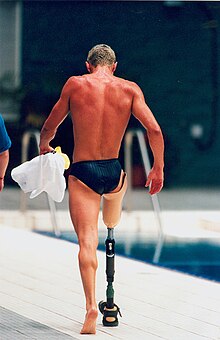
Back بدلة (جراحة ترقيعية) Arabic Protez Azerbaijani Протеза Bulgarian Protezenn (medisinerezh) Breton Proteza BS Pròtesi Catalan ئەندامی دەستکرد CKB Protéza Czech Protese Danish Prothese German

| Disability |
|---|
|
|
In medicine, a prosthesis (pl.: prostheses; from Ancient Greek: πρόσθεσις, romanized: prósthesis, lit. 'addition, application, attachment'),[1] or a prosthetic implant,[2][3] is an artificial device that replaces a missing body part, which may be lost through physical trauma, disease, or a condition present at birth (congenital disorder). Prostheses are intended to restore the normal functions of the missing body part.[4] Amputee rehabilitation is primarily coordinated by a physiatrist as part of an inter-disciplinary team consisting of physiatrists, prosthetists, nurses, physical therapists, and occupational therapists.[5] Prostheses can be created by hand or with computer-aided design (CAD), a software interface that helps creators design and analyze the creation with computer-generated 2-D and 3-D graphics as well as analysis and optimization tools.[6]
- ^ πρόσθεσις. Liddell, Henry George; Scott, Robert; A Greek–English Lexicon at the Perseus Project
- ^ Nathan, Stuart (28 November 2018). "Prosthetic implant provides realistic wrist movement to amputees". Retrieved 2019-01-30.
- ^ "Prosthetic implants – Prosthetic limbs and body parts – Plastic surgery – Services A-Z – Services". www.royalfree.nhs.uk. Retrieved 2019-01-30.
- ^ "How artificial limb is made – material, manufacture, making, used, parts, components, structure, procedure". www.madehow.com. Retrieved 2017-10-24.
- ^ "Physical Medicine and Rehabilitation Treatment Team". Department of Rehabilitation and Regenerative Medicine. Retrieved 2019-02-24.
- ^ "4: Prosthetic Management: Overview, Methods, and Materials | O&P Virtual Library". www.oandplibrary.org. Retrieved 2017-10-24.
© MMXXIII Rich X Search. We shall prevail. All rights reserved. Rich X Search